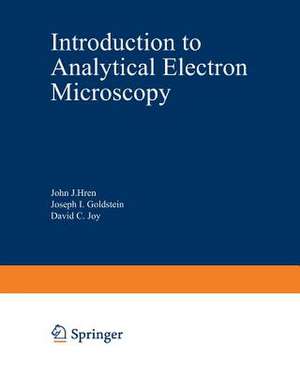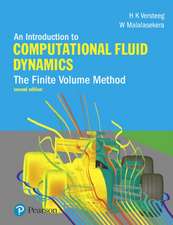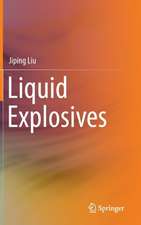Introduction to Analytical Electron Microscopy
Editat de John Hrenen Limba Engleză Paperback – 3 mar 2013
Preț: 885.13 lei
Preț vechi: 1106.42 lei
-20% Nou
Puncte Express: 1328
Preț estimativ în valută:
169.39€ • 183.93$ • 142.29£
169.39€ • 183.93$ • 142.29£
Carte disponibilă
Livrare economică 02-16 aprilie
Livrare express 18-22 martie pentru 60.79 lei
Preluare comenzi: 021 569.72.76
Specificații
ISBN-13: 9781475755831
ISBN-10: 147575583X
Pagini: 620
Ilustrații: XV, 601 p. 232 illus.
Dimensiuni: 203 x 254 x 33 mm
Greutate: 1.33 kg
Ediția:1979
Editura: Springer Us
Colecția Springer
Locul publicării:New York, NY, United States
ISBN-10: 147575583X
Pagini: 620
Ilustrații: XV, 601 p. 232 illus.
Dimensiuni: 203 x 254 x 33 mm
Greutate: 1.33 kg
Ediția:1979
Editura: Springer Us
Colecția Springer
Locul publicării:New York, NY, United States
Public țintă
ResearchDescriere
The birth of analytical electron microscopy (AEM) is somewhat obscure. Was it the recognition of the power and the development of STEM that signaled its birth? Was AEM born with the attachment of a crystal spectrometer to an otherwise conventional TEM? Or was it born earlier with the first analysis of electron loss spectra? It's not likely that any of these developments alone would have been sufficient and there have been many others (microdiffraction, EDS, microbeam fabrication, etc.) that could equally lay claim to being critical to the establishment of true AEM. It is probably more accurate to simply ascribe the present rapid development to the obvious: a combination of ideas whose time has come. Perhaps it is difficult to trace the birth of AEM simply because it remains a point of contention to even define its true scope. For example, the topics in this book, even though very broad, are still far from a complete description of what many call AEM. When electron beams interact with a solid it is well-known that a bewildering number of possible interactions follow. Analytical electron microscopy attempts to take full qualitative and quantitative advantage of as many of these interactions as possible while still preserving the capability of high resolution imaging. Although we restrict ourselves here to electron transparent films, much of what is described applies to thick specimens as well. Not surprisingly, signals from all possible interactions cannot yet (and probably never will) be attained simultaneously under optimum conditions.
Cuprins
Chpater 1 Principles of Image Formation.- Chpater 2 Introductory Electron Optics.- Chpater 3 Principles of Thin Film X-Ray Microanalysis.- Chpater 4 Quantitative X-Ray Microanalysis: Insturmental Considerations and Applications to Materials Science.- Chpater 5 EDS Quantitation and Application to Biology.- Chpater 6 Monte Carlo Simulation in Analytical Electron Microscopy.- Chpater 7 The Basic Principles of Electron Energy Loss Spectroscopy.- Chpater 8 Energy Loss Spectrometry for Biological Research.- Chpater 9 Elemental Analysis Using Inner-Shell Excitations: A Microanalytical Technique for materials Characterization.- Chpater 10 Analysis of the Electronic Structure of Solids.- Chpater 11 Stem Imaging of Crystals and Defects.- Chpater 12 Biological Scanning Transmission Electron Microscopy.- Chpater 13 Electron Microscopy of Individual Atoms.- Chpater 14 microdiffraction.- Chpater 15 Convergent Beam Electron Diffraction.- Chpater 16 Radiation Damage with Biological Specimens and Organic Materials.- Chpater 17 Radiation Effects in Analysis of Inorganic Specimens by TEM.- Chpater 18 Barriers to AEM: Contamination and Etching.- Chpater 19 Microanalysis by Lattice Imaging.- Chpater 20 Weak-Beam Microscopy.- Chpater 21 The Analysis of Defects Using Computer Simulated Images.- Chpater 22 The Strategy of Analysis.












